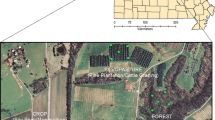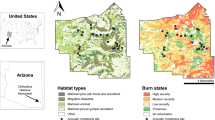Abstract
Context
Expanding oil palm plantations have caused widespread deforestation and biodiversity loss in Southeast Asia, stigmatizing the industry around the world regardless of regional context. In Latin America, oil palm plantations are primarily replacing other agroindustrial land uses with uncertain implications for local biodiversity.
Objectives
Our aim was to create empirical baseline data to help guide development of future plantations into areas where biodiversity impacts are minimized. We used soundscapes to assess fauna in oil palm landscapes of Colombia, the world’s 4th largest palm oil producer.
Methods
Soundscapes capture daily patterns of acoustic activity that can be used to measure differences between biotic communities between habitats. Using remnant forest fragments as reference sites, we sampled land use classes that are commonly replaced by commercial oil palm including cattle pastures, rice fields, and banana plantations.
Results
Soundscape analysis showed that even highly degraded forests have a unique soundscape compared to production systems. Similarities were found among closed canopy production sites (oil palm, banana) and open production habitat (pastures, rice), suggesting the importance of habitat structure for acoustic communities. Oil palm also showed notable overlap with pastures, but had soundscapes that were more similar to forest than the other production types.
Conclusions
Future oil palm development in Latin America can replace cattle pastures and other commodity plantation agriculture with minimal impacts on acoustic communities. New supply chain governance approaches such as the zero-deforestation agreements being implemented in the Colombian oil palm and cattle sectors may help guide the industry toward more sustainable development by continuing to target previously cleared lands.




Similar content being viewed by others
Change history
18 May 2019
In the original publication of the article the below given funding information was missed and now it is included in this correction
References
Aide TM, Hernandez-Serna A, Campos-Cerqueira M, Acevedo-Charry O, Deichmann JL (2017) Species richness (of insects) drives the use of acoustic space in the tropics. Remote Sens 9:1096
Alexander von Humboldt Institute (AvH) (2000) Incentivos económicos perversos para la conservación de la biodiversidad: el caso de la palma africana. Biosíntesis. Instituto de Investigaciones de Recursos Biológicos Alexander von Humboldt, Bulletin no. 21, ISSN-0123-7896
Azhar B, Lindenmayer DB, Wood J, Fischer J, Manning A, McElhinny C, Zakaria M (2011) The conservation value of oil palm plantation estates, smallholdings and logged peat swamp forest for birds. For Ecol Manag 262:2306–2315
Barnes AD, Jochum M, Mumme S, Haneda NF, Farajallah A, Widarto TH, Brose U (2014) Consequences of tropical land use for multitrophic biodiversity and ecosystem functioning. Nat Commun 5:5351
Barraza D, van de Wendel Joode B, Jansen K, Wesseling C (2011) Pesticide use in banana and plantain production and risk perception among local actors in Talamanca, Costa Rica. Environ Res 111(5):708–717
Bobryk CW, Rega-Brodsky CC, Bardhan S, Farina A, He HS, Jose S (2016) A rapid soundscapes analysis to quantify conservation benefits of temperate agroforestry systems using low-cost technology. Agrofor Syst 90(6):997–1008
Boelman NT, Asner GP, Hart PJ, Martin RE (2007) Multi-trophic invasion resistance in Hawaii: bioacoustics, field surveys, and airborne remote sensing. Ecol Appl 17(8):2137–2144
Burivalova Z, Towsey M, Boucher T, Truskinger A, Apelis Cosmas, Roe P, Game ET (2017) Using soundscapes to detect variable degrees of human influence on tropical forests in Papua New Guinea. Conserv Biol 32(1):205–215
Campos-Cerqueira M, Aide TM (2017) Changes in the acoustic structure and composition along a tropical elevational gradient. J Ecoacoustics 1:PNCO71
Castiblanco C, Etter A, Aide TM (2013) Oil palm plantations in Colombia: a model of future expansion. Environ Sci Policy 27:172–183
Chaudhary A, Burivalova Z, Koh LP, Hellweg S (2016) Impact of forest management on species richness: Global meta-analysis and economic trade-offs. Sci Rep 6:23954
Correa FS, Juen L, Rodrigues LC, Silva-Filho HF, Santos-Costa MC (2015) Effects of oil palm plantations on anuran diversity in the eastern Amazon. Anim Biol 65:321–335
Danielsen F, Beukema H, Burgess N, Parish F, Bruhl CA, Donald PF, Murdiyarso D, Phalan B, Reijnders L, Struebig M, Fitzherbert EB (2009) Biofuel plantations on forested lands: double jeopardy for biodiversity and climate. Conserv Biol 23:349–358
de Carvalho CM, Silveira S, La Rovere EL, Iwama AY (2015) Deforested and degraded land available for the expansion of palm oil for biodiesel in the state of Pará in the Brazilian Amazon. Renew Sustain Energy Rev 44:867–876
Deichmann JL, Hernández-Serna A, Delgado C, Campos-Cerqueira M, Aide TM (2017) Soundscape analysis and acoustic monitoring document impacts of natural gas exploration on biodiversity in a tropical forest. Ecol Ind 74:39–48
Deichmann JL, Acevedo-Charry O, Barclay L, Burivalova Z, Campos-Cerqueira M, d'Horta F, Game ET, Gottesman BL, Hart PJ, Kalan AK, Linke S, Nascimento LD, Pijanowski B, Staaterman E, Mitchell Aide T (2018) It's time to listen: there is much to be learned from the sounds of tropical ecosystems. Biotropica 50(5):713–718
Dislich C, Alexander CK, Salecker J, Kisel Y, Meyer KM, Auliya M, Barnes AD, Corre MD, Darras K, Faust H, Hess B, Klasen S, Knohl A, Kreft H, Meijide A, Nurdiansyah F, Otten F, Pe’er G, Steinbach S, Tarigan S, Tolle MH, Tscharntke T, Wiegand A (2017) A review of the ecosystem functions in oil palm plantations, using forests as a reference system. Biol Rev 92(3):1539–1569
Dufrene M, Legendre P (1997) Species assemblages and indicator species: the need for a flexible asymmetrical approach. Ecol Monogr 67(3):345–366
Eakin H, Rueda X, Mahanti A (2017) Transforming governance in telecoupled food systems. Ecol Soc 22(4):32
Edwards DP, Hodgson JA, Hamer KC, Mitchell SL, Ahmad AH, Cornell SJ, Wilcove DS (2010) Wildlife-friendly oil palm plantations fail to protect biodiversity effectively. Conserv Lett 3(4):236–242
Etter A, McAlpine C, Possingham H (2008) Historical patterns and drivers of landscape change in Colombia since 1500: a regionalized spatial approach. Ann Assoc Am Geogr 98:2–23
Federación Nacional de Cultivadores de Palma de Aceite (Fedepalma) (2017) Anuario Estadistico. https://publicaciones.fedepalma.org/index.php/anuario/issue/view/1346. Accessed 24 Nov 2018
Fishman A, Oliveira E, Gamble L (2017) Tackling deforestation through a jurisdictional approach: lessons from the field. Tropical Forest Alliance 2020 and World Wildlife Fund (WWF). https://www.tfa2020.org/wp-content/uploads/2017/11/wwf_jurisdictional_approaches_fullpaper_web_1.pdf. Accessed 6 Oct 2018
Foster WA, Snaddon JL, Turner EC, Fayle TM, Cockerill TD, Farnon Ellwood MD, Broad GR, Chung AY, Vun Eggleton P, Khen C, Yusah KM (2011) Establishing the evidence base for maintaining biodiversity and ecosystem function in the oil palm landscapes of South East Asia. Philos Trans R Soc B 366:3277–3291
Furumo PR, Aide TM (2017) Characterizing commercial oil palm expansion in Latin America: land use change and trade. Environ Res Lett 12:041001
Garcia-Ulloa J, Sloan S, Pacheco P, Ghazoul J, Koh LP (2012) Lowering environmental costs of oil-palm expansion in Colombia. Conserv Lett 5:266–275
Gaveau DLA, Sheil D, Husnayaen, Salim MA, Arjasakusuma S, Ancrenaz M, Pacheco P, Meijaard E (2016) Rapid conversions and avoided deforestation: examining four decades of industrial plantation expansion in Borneo. Sci Rep 6:32017
Gibson L, Lee TM, Koh LP, Brook BW, Gardner TA, Barlow J, Peres CA, Brradshaw CJA, Laurance WF, Lovejoy TE, Sodhi NS (2011) Primary forests are irreplaceable for sustaining tropical biodiversity. Nature 478:378–381
Gilroy JJ, Prescott GW, Cardenas JS, Castaneda PG, Sanchez A, Rojas-Murcia LE, Uribe CA, Haugaasen T, Edwards DP (2014) Minimizing the biodiversity impact of Neotropical oil palm development. Glob Change Biol 21:1531–1540
Hennenberg KJ, Dragisic C, Haye S, Hewson J, Semroc B, Savy C, Wiegmann K, Fehrenbach H, Fritsche UR (2009) The power of bioenergy-related standards to protect biodiversity. Conserv Biol 42(2):412–423
Knowlton JL, Phifer CC, Cerqueira PV, Carvalho Barro F, Oliveira SL, Fiser CM, Becker NM, Cardoso MR, Flaspohler DJ, Dantas Santos MP (2017) Oil palm plantations affect movement behavior of a key member of mixed-species flocks of forest birds in Amazonia, Brazil. Trop Conserv Sci 10:1–10
Koh LP (2008) Can oil palm plantations be made more hospitable for forest butterflies and birds? J Appl Ecol 45:1002–1009
Koh LP, Wilcove DS (2008) Is oil palm agriculture really destroying tropical biodiversity? Conserv Lett 1:60–64
Lambin EF, Meyfroidt P (2011) Global land use change, economic globalization, and the looming land scarcity. PNAS 108(9):3465–3472
Lambin EF, Gibbs HK, Heilmayr R, Carlson KM, Fleck LC, Garrett RG, le Polain de Waroux Y, McDermott CL, Mclaughlin D, Newton P, Nolte C, Pacheco P, Rausch LL, Streck C, Thorlakson T, Walker NF (2018) The role of supply-chain initiatives in reducing deforestation. Nat Clim Change 8:109–116
Lucey JM, Tawatao N, Senior MJM, Vun Khen C, Benedick S, Hamer KC, Woodcock P, Newton RJ, Bottrell SH, Hill JK (2014) Tropical forest fragments contribute to species richness in adjacent oil palm plantations. Biol Conserv 169:268–276
Luskin MS, Potts MD (2011) Microclimate and habitat heterogeneity through the oil palm lifecycle. GFO 12:540–551
Meijaard E, Garcia-Ulloa J, Sheil D, Wich SA, Carlson KM, Juffe-Bignoli D, Brooks TM (eds) (2018) Oil palm and biodiversity. A situation analysis by the IUCN Oil Palm Task Force. IUCN Oil Palm Task Force Gland, Switzerland: IUCN
Meyfroidt P, Carlson KM, Fagan ME, Gutierrez-Velez VH, Macedo MN, Curran LM, DeFries RS, Dyer GA, Gibbs HK, Lambin EF, Morton DC, Robiglio V (2014) Multiple pathways of commodity crop expansion in tropical forest landscapes. Environ Res Lett 9:074012
Ocampo- Peñuela N, Garcia-Ulloa J, Ghazoul J, Etter A (2018) Quantifying impacts of oil palm expansion on Colombia’s threatened biodiversity. Biol Conserv 224:117–121
Oksanen J (2014) Cluster analysis: tutorial with R. R Package Version 3(3):3
Ospina B, Ochoa J (1998) La palma africana en Colombia: Apuntes y memorias. Fedepalma, Bogota
Pardo LE, Laurance WF, Clements GP, Edwards W (2015) The impacts of oil palm agriculture on Colombia’s biodiversity: what we know and still need to know. Trop Conserv Sci 8(3):828–845
Pekin BK, Jung J, Villanueva-Rivera LJ, Pijanowski BC, Ahumada JA (2012) Modeling acoustic diversity using soundscape recordings and LIDAR-derived metrics of vertical forest structure in a neotropical rainforest. Landscape Ecol 27(10):1513–1522
Pijanowski BC, Farina A, Gage SH, Dumyahn SL, Krause BL (2011) What is soundscape ecology? An introduction and overview of an emerging new science. Landscape Ecol 26(9):1213–1232
Richardson DL (1995) The history of oil palm breeding in the United Fruit Company. Asd Oil Palm Pap 11:1–22
Rodriguez A, Gasc A, Pavoine S, Grandcolas P, Gaucher P, Sueur J (2014) Temporal and spatial variability of animal sound within a neotropical forest. Ecol Inform 21:133–143
Rueda X, Garrett RD, Lambin EF (2017) Corporate investments in supply chain sustainability: selecting instruments in the agri-food industry. J Clean Prod 142:2480–2492
Savilaakso S, Garcia C, Garcia-Ulloa, Ghazou J, Groom M, Guariguata MR, Laumonier Y, Nasi R, Petrokofsky G, Snaddon J, Zrust M (2014) Systematic review of effects on biodiversity from oil palm production. Environ Evid 3:4
Tapasco J, Martínez J, Calderón S, Romero G, Ordóñez DA, Álvarez A, Sánchez-Aragón L, Ludeña CE (2015). Impactos Económicos del Cambio Climático en Colombia: Sector Ganadero. Banco Interamericano de Desarrollo, Monografía No. 254, Washington D.C
Tropical Forest Alliance (TFA) 2020 (2017) Zero-Deforestation Public-Private Alliance, TFA2020 Colombia. https://www.tfa2020.org/wp-content/uploads/2017/11/TFA-2020-Colombian-Alliance-Concept_Objectives_ENG.pdf. Accessed 24 Nov 2018
Tucker D, Gage SH, Williamson I, Fuller S (2014) Linking ecological condition and the soundscape in fragmented Australian forests. Landscape Ecol 29(4):745–758
Yu Ting JK, Shogo K, Jarzebski MP (2016) The efficacy of voluntary certification standards for biodiversity conservation. In: Certification and biodiversity—How voluntary certification standards impact biodiversity and human livelihoods. Policy Matters 21:26–44 Gland, Switzerland: CEESP and IUCN
Author information
Authors and Affiliations
Corresponding author
Additional information
Publisher's Note
Springer Nature remains neutral with regard to jurisdictional claims in published maps and institutional affiliations.
Electronic supplementary material
Below is the link to the electronic supplementary material.
Rights and permissions
About this article
Cite this article
Furumo, P.R., Mitchell Aide, T. Using soundscapes to assess biodiversity in Neotropical oil palm landscapes. Landscape Ecol 34, 911–923 (2019). https://doi.org/10.1007/s10980-019-00815-w
Received:
Accepted:
Published:
Issue Date:
DOI: https://doi.org/10.1007/s10980-019-00815-w




